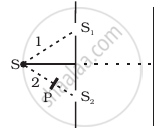Advertisements
Advertisements
प्रश्न
What is the Brewster angle for air to glass transition? (Refractive index of glass = 1.5)
उत्तर
Refractive index of glass, μ = 1.5
Brewster angle = θ
Brewster angle is related to refractive index as:
tan θ = μ
θ = tan−1 (1.5) = 56.31°
Therefore, the Brewster angle for air to glass transition is 56.31°.
APPEARS IN
संबंधित प्रश्न
Why does an unpolarised light incident on a polaroid get linearly polarised ?
A beam of unpolarised light is incident on a glass-air interface. Show, using a suitable ray diagram, that light reflected from the interface is totally polarised, when μ = tan iB, where μ is the refractive index of glass with respect to air and iB is the Brewster's angle.
Using the phenomenon of polarisation, show how the transverse nature of light can be demonstrated.
The refractive indices of water for red and violet colours are 1.325 and 1.334 respectively.
Find the difference between the velocities of rays for these two colours in water. (c = 3 × 108 m/s)
Unpolarised light is passed through a polaroid P1. When this polarised beam passes through another polaroid P2 and if the pass axis of P2 makes angle θ with the pass axis of P1, then write the expression for the polarised beam passing through P2. Draw a plot showing the variation of intensity when θ varies from 0 to 2π.
State two uses of Polaroid.
The glass plate of refractive index 1.732 is to be used as a polarizer, its polarising angle is _______.
A ray of light is incident on a transparent medium at a polarizing angle. What is the angle between the reflected ray and the refracted ray?
What is the difference between polarised light and unpolarised light?
Discuss polarisation by selective absorption.
What is a analyser?
What is double refraction?
Mention the types of optically active crystals with example.
A plane mirror produces a magnification of
Which of the following phenomena is not common to sound and light waves?
Figure shown a two slit arrangement with a source which emits unpolarised light. P is a polariser with axis whose direction is not given. If I0 is the intensity of the principal maxima when no polariser is present, calculate in the present case, the intensity of the principal maxima as well as of the first minima.

A polarizer - analyser set is adjusted such that the intensity of light coming out of the analyser is just 10% of the original intensity. Assuming that the polarizer - analyser set does not absorb any light, the angle by which the analyser need to be rotated further to reduce the output intensity to be zero, is ______.
